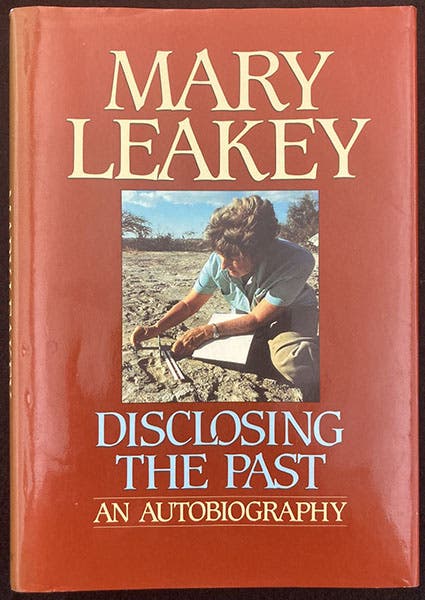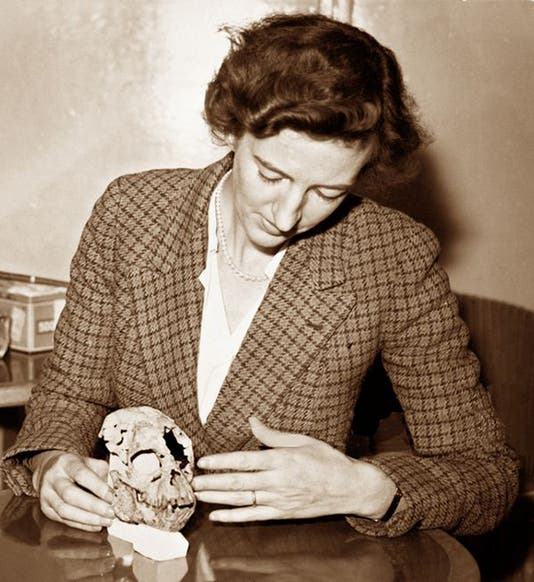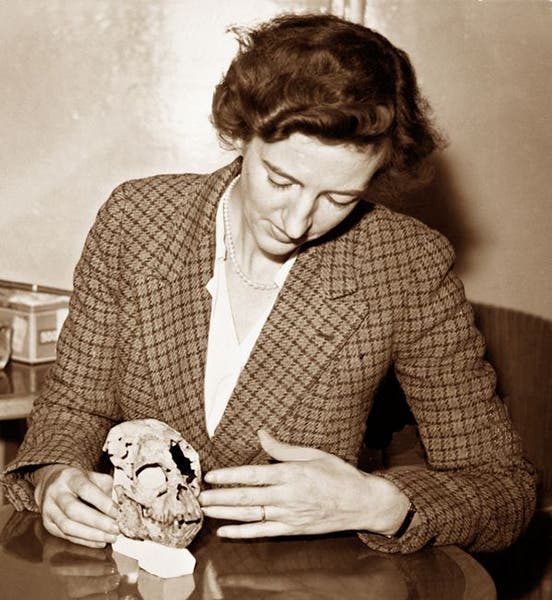Scientist of the Day - Mary Leakey
Mary Leakey, an English anthropologist, was born Feb. 6, 1913, as Mary Douglas Nicol. She never enrolled in a university, but she took courses in archaeology and drawing in London, and found a niche as an archaeological artist. When Louis Leakey came to England and was looking for an illustrator his forthcoming first book, the two met, launched into an affair (Louis was married), and after his divorce, they were married. Mary headed for Nairobi with Louis, and she would spend most of the rest of her life in East Africa. She and Louis began to excavate at Olduvai Gorge in Tanzania, and they started a family as well, bringing three sons into the world. We published a post on Louis Leakey last summer.
In most of photographs that show Louis and Mary together, Louis is careful to place himself in the foreground, with Mary behind. Here is a link to one of those. But there are several unstaged photos of the two in which Mary occupies the foreground; we chose one of those, which also captures the awkward positions in which archaeologists and paleoanthropologists spend much of their lives (second image)
On Oct. 2, 1948, Mary found the fragments of an ape skull on Rusinga Island in Lake Victoria in Kenya. The deposits were Miocene, about 18 million years old, meaning that they dated well before the first appearance of humans, and so it was possible that this Miocene ape would shed light on human evolution. Fragments of Proconsul, as the ape was called, had been known since 1909, but this was the first useful fossil that could shed light on Proconsul's physical nature. Mary assembled the 30 fragments and found a complete mandible and a partial skull, but it was missing the occipital region of the braincase). A photograph (first image) shows Mary with the Proconsul skull in 1948.
Amazingly, a colleague, 20 years later, spotted in the Nairobi Museum some fragments of what were labelled tortoise scutes, "Rusinga Island, 1947". They turned out to be the missing fragments of the skull. Mary later said that they she and Louis celebrated the discovery in one of the few ways possible on an isolated island, and the fruit of their party was their third son, Phillip. It is still not exactly clear what Proconsul was, although 4 species have now been named, and whether it is even a hominoid. Mary discusses this discovery, and her turbulent life with her husband, in her autobiography, Disclosing the Past (1984; third image)

Dust jacket of Disclosing the Past: An Autobiography, by Mary Leakey, Doubleday, 1984 (author’s copy)
In a previous post, we discussed another of her famous finds, that of the hominid "Zinj," a robust australopithecine, in 1959 (our post has several further photographs of Mary, different from the ones we include here). But perhaps Mary's most famous discovery came in 1978. In 1976, she had discovered some footprints in solidified volcanic ash at Laetoli, Tanzania. Laetoli (pronounced LYE-a-TO-li) is some thirty miles south of Olduvai Gorge, where Mary had found Zinj. After Louis died in 1972, Mary carried on alone, and she began working the Laetoli site in 1976. About 3.7 million years ago, the area had been covered several times with ash layers from nearby volcanoes, and between eruptions, after it rained, many creatures had left their footmarks in the moistened ash. The footprints Mary first observed in the fall of 1976 were not hominid prints. But by 1978, she had uncovered trails of footprintsthat were clearly made by bipedal primates, or hominins; the most famous one shows the track of an adult biped, striding across the ash, and right next to it, a parallel trail made by a smaller biped, perhaps a child, and yet a third, who followed in the footprints of the first (fourth image).
The Laetoli footprints are the most dramatic piece of evidence we have that prehuman bipeds were walking the savannas of Africa 3.7 million years ago (appealing though it is to think so, there is no evidence that these were the tracks of a family). The bipedal hominin "Lucy" (Australopithecus afarensis) had been discovered in Ethiopia in 1974 by Donald Johansson, but it was only named and announced in 1978, the year of Mary Leakey’s discovery, and it soon became apparent that Lucy's relatives were the ones who made the tracks. The noted anthropological photographer John Reader recorded the Laetoli hominid trail immediately after it was laid bare (fourth image), which is fortunate, because the tracks were soon thereafter covered back over with earth to prevent their rapid erosion and deterioration.
Mary died on Dec. 9, 1996, in Nairobi, at age 83. She was honored in 2013, on the centennial of her birth, with a Google Doodle, and also, that same year, with a place in the pantheon of Great Britons, an issue of ten commemorative postage stamps released by the Royal Mail (fifth image). Mary is in the center of the top row.
The Leakey’s middle son, Richard, became an eminent anthropologist in his own right. We published a post on Richard less than two months ago.
William B. Ashworth, Jr., Consultant for the History of Science, Linda Hall Library and Associate Professor emeritus, Department of History, University of Missouri-Kansas City. Comments or corrections are welcome; please direct to ashworthw@umkc.edu.










